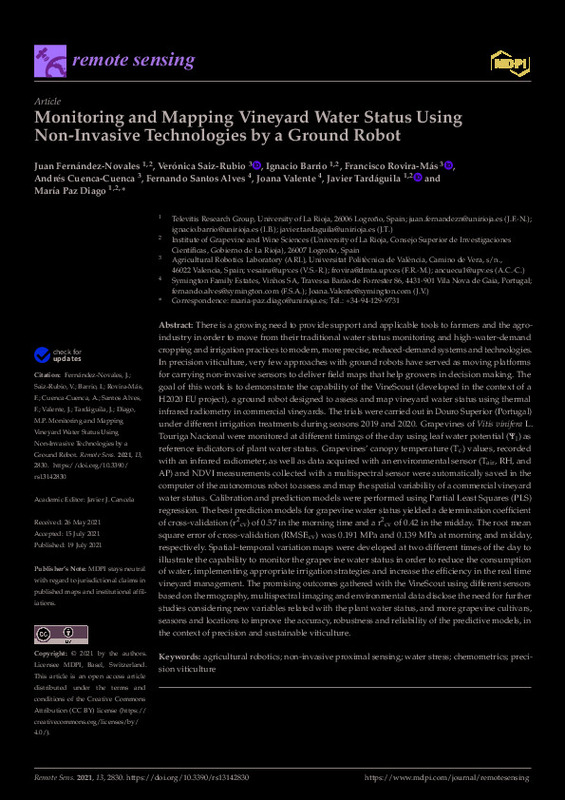JavaScript is disabled for your browser. Some features of this site may not work without it.
Buscar en RiuNet
Listar
Mi cuenta
Estadísticas
Ayuda RiuNet
Admin. UPV
Monitoring and Mapping Vineyard Water Status Using Non-Invasive Technologies by a Ground Robot
Mostrar el registro sencillo del ítem
Ficheros en el ítem
| dc.contributor.author | Fernández-Novales, Juan
|
es_ES |
| dc.contributor.author | Saiz Rubio, Verónica
|
es_ES |
| dc.contributor.author | Barrio, Ignacio
|
es_ES |
| dc.contributor.author | Rovira Más, Francisco
|
es_ES |
| dc.contributor.author | Cuenca-Cuenca, Andrés
|
es_ES |
| dc.contributor.author | Alves, Fernando Santos
|
es_ES |
| dc.contributor.author | Valente, Joana
|
es_ES |
| dc.contributor.author | Tardáguila, Javier
|
es_ES |
| dc.contributor.author | Diago, María Paz
|
es_ES |
| dc.date.accessioned | 2022-10-07T18:06:31Z | |
| dc.date.available | 2022-10-07T18:06:31Z | |
| dc.date.issued | 2021-07 | es_ES |
| dc.identifier.issn | 2072-4292 | es_ES |
| dc.identifier.uri | http://hdl.handle.net/10251/187272 | |
| dc.description.abstract | [EN] There is a growing need to provide support and applicable tools to farmers and the agro-industry in order to move from their traditional water status monitoring and high-water-demand cropping and irrigation practices to modern, more precise, reduced-demand systems and technologies. In precision viticulture, very few approaches with ground robots have served as moving platforms for carrying non-invasive sensors to deliver field maps that help growers in decision making. The goal of this work is to demonstrate the capability of the VineScout (developed in the context of a H2020 EU project), a ground robot designed to assess and map vineyard water status using thermal infrared radiometry in commercial vineyards. The trials were carried out in Douro Superior (Portugal) under different irrigation treatments during seasons 2019 and 2020. Grapevines of Vitis vinifera L. Touriga Nacional were monitored at different timings of the day using leaf water potential (psi(l)) as reference indicators of plant water status. Grapevines' canopy temperature (T-c) values, recorded with an infrared radiometer, as well as data acquired with an environmental sensor (T-air, RH, and AP) and NDVI measurements collected with a multispectral sensor were automatically saved in the computer of the autonomous robot to assess and map the spatial variability of a commercial vineyard water status. Calibration and prediction models were performed using Partial Least Squares (PLS) regression. The best prediction models for grapevine water status yielded a determination coefficient of cross-validation (r(cv)(2)) of 0.57 in the morning time and a r(cv)(2) of 0.42 in the midday. The root mean square error of cross-validation (RMSEcv) was 0.191 MPa and 0.139 MPa at morning and midday, respectively. Spatial-temporal variation maps were developed at two different times of the day to illustrate the capability to monitor the grapevine water status in order to reduce the consumption of water, implementing appropriate irrigation strategies and increase the efficiency in the real time vineyard management. The promising outcomes gathered with the VineScout using different sensors based on thermography, multispectral imaging and environmental data disclose the need for further studies considering new variables related with the plant water status, and more grapevine cultivars, seasons and locations to improve the accuracy, robustness and reliability of the predictive models, in the context of precision and sustainable viticulture. | es_ES |
| dc.description.sponsorship | This research was funded by the European Union under grant agreement number 737669 (Vinescout project). | es_ES |
| dc.language | Inglés | es_ES |
| dc.publisher | MDPI AG | es_ES |
| dc.relation.ispartof | Remote Sensing | es_ES |
| dc.rights | Reconocimiento (by) | es_ES |
| dc.subject | Agricultural robotics | es_ES |
| dc.subject | Non-invasive proximal sensing | es_ES |
| dc.subject | Water stress | es_ES |
| dc.subject | Chemometrics | es_ES |
| dc.subject | Precision viticulture | es_ES |
| dc.subject.classification | INGENIERIA AGROFORESTAL | es_ES |
| dc.title | Monitoring and Mapping Vineyard Water Status Using Non-Invasive Technologies by a Ground Robot | es_ES |
| dc.type | Artículo | es_ES |
| dc.identifier.doi | 10.3390/rs13142830 | es_ES |
| dc.relation.projectID | info:eu-repo/grantAgreement/EC/H2020/737669/EU | es_ES |
| dc.rights.accessRights | Abierto | es_ES |
| dc.contributor.affiliation | Universitat Politècnica de València. Departamento de Ingeniería Rural y Agroalimentaria - Departament d'Enginyeria Rural i Agroalimentària | es_ES |
| dc.description.bibliographicCitation | Fernández-Novales, J.; Saiz Rubio, V.; Barrio, I.; Rovira Más, F.; Cuenca-Cuenca, A.; Alves, FS.; Valente, J.... (2021). Monitoring and Mapping Vineyard Water Status Using Non-Invasive Technologies by a Ground Robot. Remote Sensing. 13(14):1-20. https://doi.org/10.3390/rs13142830 | es_ES |
| dc.description.accrualMethod | S | es_ES |
| dc.relation.publisherversion | https://doi.org/10.3390/rs13142830 | es_ES |
| dc.description.upvformatpinicio | 1 | es_ES |
| dc.description.upvformatpfin | 20 | es_ES |
| dc.type.version | info:eu-repo/semantics/publishedVersion | es_ES |
| dc.description.volume | 13 | es_ES |
| dc.description.issue | 14 | es_ES |
| dc.relation.pasarela | S\442914 | es_ES |
| dc.contributor.funder | COMISION DE LAS COMUNIDADES EUROPEA | es_ES |
| dc.subject.ods | 03.- Garantizar una vida saludable y promover el bienestar para todos y todas en todas las edades | es_ES |
| dc.subject.ods | 06.- Garantizar la disponibilidad y la gestión sostenible del agua y el saneamiento para todos | es_ES |
| dc.subject.ods | 12.- Garantizar las pautas de consumo y de producción sostenibles | es_ES |
| dc.subject.ods | 13.- Tomar medidas urgentes para combatir el cambio climático y sus efectos | es_ES |
| upv.costeAPC | 785,57 | es_ES |








